Hand and easel anti-tank grenade launchers
The launch of powder rockets from the shoulder of a tubular guide was developed by Kongreg in the first half of the 19th century. At the same time, such installations were used as "commercial" harpoon rockets. In the 60 of the XIX century, the principles of "hopeless shooting" were actively explored. Several schemes of recoilless guns were created during the First World War (“Gelvih gun”, “Davis gun”, “Ryabushinsky gun” and others). In the 30-ies of the XX century in various countries, attempts were made to adapt recoilless and reactive schemes in anti-tank weapons.
Let's start with the Soviet Union, although it was here that anti-tank grenade launchers were not accepted for service until the end of the war. Although in 1931, the 65-millimeter "jet gun" of Petropavlovsky, created in the Gas-Dynamic Laboratory, was tested. The design of this gun had a number of promising elements: launch from the shoulder, the use of light alloys, an engine electric igniter, a shield designed to protect against a muzzle wave and gases. In 1933, after the death of Petropavlovsk, this development was not continued. At the beginning of the 1933 of the year, the 37-millimeter "dynamo-reactive anti-tank rifles" by L.V. Kurchevsky RK of small and high power (the mass of guns was 28 and 32 kilograms, respectively, according to various sources, it was supplied from 180 to 325 RK). However, two years later they were decommissioned, since they did not meet the requirements of armor penetration, safety and maneuverability. Note that the failure of Kurchevsky’s work for a certain period of time undermined confidence in recoilless systems. Probably, therefore, the more successful 37-millimeter self-loading "rotary jet gun" developed by S.Е. Rashkov and M.N. Kondakov in 1935 — 1936 in the design bureau of the Academy (with a mass of 63 kilogram, it showed armor penetration and accuracy, close to the standard 37-millimeter anti-tank gun model 1930 of the year). In 1934, the OKB PI Grokhovsky proposed a simple "manual dynamo-reactive launcher" designed to destroy lightly armored targets. Works on recoilless (dynamo-reactive) systems were also carried out by E.А. Berkalov and V.M. Trofimov. The armor-piercing action of the projectiles was based on their kinetic energy and at low speeds was not enough. For a number of reasons - among which there were repressions against design personnel - these works were stopped (in 1943, Stalin allegedly remarked on this occasion: "They splashed out the child along with dirty water"). To work back during the war.
In 1942, M.L. Miles developed a light anti-tank missile weapon. At that time, SKB at the Kompressor plant took up “machines for 82 mm anti-tank mines” (missiles): a launch machine with a pair of guides was created under the leadership of Vasiliev. This work was not continued, although shooting at tanks Eresami direct fire from the ground and from aircraft with heavy rockets showed good results - light and medium German tanks were destroyed when the M30 and M31 ruptured, even at a distance of about 10 meters from them. A heavy M30 shell (warhead 29,9 kg) introduced in the middle of 42 years could be launched from a direct-fire portable single-shot machine - this complex was designed to destroy fortifications, but could be used against tanks, although accuracy and accuracy were insufficient.
Marshal of artillery Yakovlev, who during the war years was the head of the GAU, explained the lack of anti-tank grenade launchers in the Red Army as follows: "Such means of fighting tanks as there were no active supporters like faustpatron ... But they proved themselves very well." However, this does not mean that such developments did not receive support. For example, already in 1944, two reusable hand-held grenade launchers with an over-caliber grenade were developed. At the Research and Development Range of the small-arms and mortar weapons of the GAU under the direction of G.P. Lominsky developed LPG-44 with grenade PG-70. In GSKB-30 when the plant number 58 them. K.E. Voroshilov under the direction of A.V. Smolyakova - DRG-40 grenade launcher with PG-80 grenade. But even this seemingly “simple” product, like a hand-held anti-tank grenade launcher, required the solution of some technological and design problems, and the beginning of the mass production of some of its elements was a significant investment, which was especially difficult in wartime.
The LPG-44 included a smooth 30-mm launch tube, a simple descent, a trigger hammer, a folding aiming bar and protective pads. The 70-mm cumulative PG-70 grenade had a propellant charge of smoke powder (the powder burned before departure from the pipe) and a hard stabilizer. Aiming was made on the rim of a grenade, similar to the German “Panzerfaust”. In the spring of 1944, tests were conducted. At the beginning of the 1945, the grenade (shot) received the designation PG-1, the grenade launcher RPG-1, the production of the installation batch was prepared, but the grenade revision was delayed, and the grenade launcher was ready only in 1946 year. The range of the direct shot was equal to 50-75 meters, the maximum - 150 meters, armor penetration to 150 millimeters. In 1948, work on the RPG-1 was discontinued, and the following year, the RPG-2 grenade launcher was adopted. This happened in the framework of the new infantry weapons system. RPG-2 was the brainchild of GSKB-30. The RPG-2 grenade launcher included a 40-mm tube, equipped with protective plates, a pistol grip, and a trigger hammer mechanism. The 80 mm cumulative PG-2 grenade was screwed with a propellant charge of black powder. In RPG-2 blank range in 3-4 times higher than the RPG-1, the effective shooting range - up to 150 meters, sighting range - 300 meters (for bronetselyam) - 700 meters (for firing points) armor to 200 millimeters .
In the special of those. NII-6 Bureau of the People's Commissariat of Ammunition, headed by I.M. Nayman, a group of designers on the instructions of NKBP was developed "active" hand-held grenade launcher PG-6. With the help of a special blank cartridge, a cumulative RPG-6 grenade was fired, piercing armor up to 120 millimeters, in a pallet or a regular 50-millimeter fragmentation feathered mine. The ground test system passed in July 1944. In November of this year, the People's Commissariat ordered a batch for military trials if the recoil forces were reduced and the firing range was increased. Several such anti-tank grenades were prepared for the 1945 year. The weight of the system was 18 kilogram, the range of RPG-6 grenade firing at tanks - up to 150 meters, 50-mm mine in manpower - up to 500 meters. PG-6 could also be used as an anti-aircraft mine (it should be noted that DM Karbyshev offered an anti-aircraft mine "according to the mortar principle" as early as 1940 year).

Work on this system with the end of the war stopped.
Naturally, in the course of development, the experience of the allies and the enemy was used - all transferred weapons of the allies and captured samples of German weapons were carefully studied and evaluated by domestic experts. Note that in Berlin, at the headquarters of the Soviet military administration in May 1945, a technical commission formed the main purpose, which was to collect data on German weapons and reactive technology, including anti-tank weapons. However, even a brief review of Soviet prototypes shows that there was no “direct borrowing” here. And although during the Second World War our army did not receive an anti-tank grenade launcher, it was then that the foundation was laid for their post-war development.
In Germany, things were different. Here, in 30-s, a lot of effort and money was spent on “dynamo-reactive” and “reactive” topics. In 1943, the “Arms of infantry weapons program” was adopted in Germany, which was updated and supplemented at the beginning of 1944. In this program, special attention was paid to anti-tank weapons. Within its framework, fundamentally new anti-tank grenade launchers were adopted by the infantry.
Reusable anti-tank rocket launcher was created on the basis of the Schulder 75 rocket launcher. It took into account the experience of American "bazook", which were seized in North Africa. A new weapon was intended to fight all types of tanks.
In March, 1943, at the Kummersdorf test site, captured American bazookas and their own designs were demonstrated. After that, the SV Armaments Directorate, which had previously taken on “Schulder 75” coldly, decided to speed up development in this area. At the end of the 1943, the Wehrmacht adopted the 8,8-cm R.Pz.B. 54 ”(“ Raketenpanzerbuchse 54 ”or“ 43 ”). The hand-held anti-tank grenade launcher, better known as the “Ofenror” (“offenrohr” - “chimney” or “open pipe”, named because of flames and smoke escaping from the official cut), consisted of a smooth-walled seamless pipe-trunk, shoulder rest having a shoulder pad , cocking handles (fitted with a fuse), handles with a trigger mechanism, brackets, sighting devices, a plug contact box, a latch holding a grenade in the barrel. For carrying there was a shoulder strap attached to the pipe.
Along the entire length of the trunk there were three stamped rectangular guides. On the breech cut, a wire ring was fastened, which protected from damage and contamination, and also facilitated insertion of a grenade from the breech section. A pulse generator was used to operate an electric ignition device. The core of the generator - the rod - was cocked by a special swinging handle located in front of the trigger, while the fuse was recessed. The voltage to the contact box was supplied by protected wires. On the left side were sights, which included a front sight (front viewfinder) and a frame with a slot (rear viewfinder). The position of the slot was adjusted during the shooting. The handles of holding were formed by wooden overlays located on a rectangular metal bracket under the pipe.
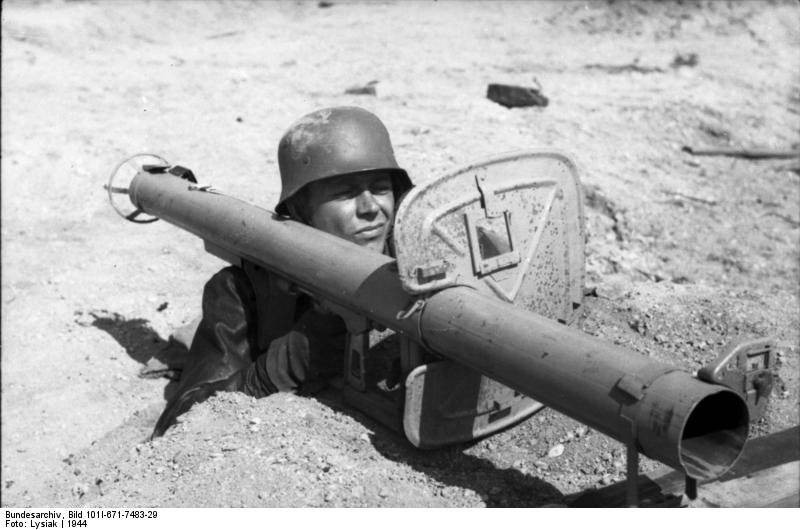
The rocket grenade case "8,8-cm R.Pz.B.Gr. 4322 "had a shaped charge (TNT and RDX) and an AZ AZ 5075 impact head fuse equipped with a safety check. The grenade had a powder engine, a ring stabilizer was attached to its nozzle, and a wooden block to which the contacts of the electric fuse were removed. The tail part and the body were threaded. Pomegranate was stained in dark green. Before loading, they took out the fuse's check and removed the adhesive tape covering the terminal block. The fuse platoon occurred after the shot, when the grenade was about three meters away from the muzzle. The length of the grenade was 655 millimeters, armor penetration along the normal was 150 millimeters. On the tail end of the grenade with the engine, which was adapted to winter conditions, there was an inscription “arkt” - the powder charge created more pressure and worked more reliably at temperatures below -5 ° C. In addition to the “arctic”, a “tropical” grenade was designed for combat Action in North Africa. There were also training grenades "4320 Ex", "4320 Ub" and "4340 Ub".
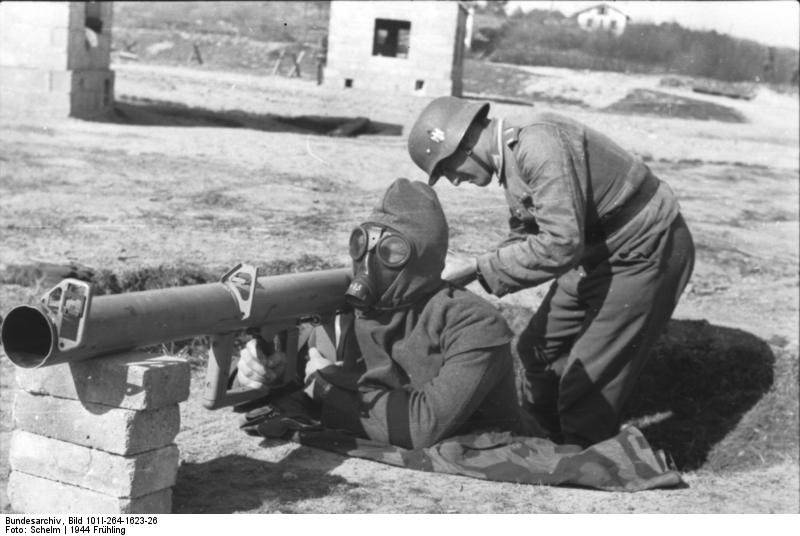
Shooting led from the shoulder. The gunner had to wear a helmet, gloves, a hood and an antigas mask to protect against the powder gases of the engine. In 1944, the anti-tank grenade launcher was equipped with a light cover in the form of a rectangular shield with a window for aiming. In addition, a box was added for small parts. The shield on the pipe was attached with a detachable coupling. Safety bracket was installed under the muzzle of the barrel. New model R.Pz.B. 54 / 1 called "Panzershrek" ("panzerschreck" - a storm of tanks).
The Pantsershrek and Ofenror were more cumbersome than the American Bazooka’s M1, but were significantly superior to this armored penetration grenade launcher. In combat conditions, the generator was more reliable than batteries; a convenient contact box significantly accelerated loading. From 1943 to 1945, approximately 300 thousand anti-tank grenade launchers were produced annually. The main unmasking factor of hand-held anti-tank grenade launchers, as well as recoilless guns, was a gas-dust cloud raised by powder gases behind the barrel. During the Berlin operation, the Soviet forces encountered “self-propelled tank destroyers” - B-IV tankettes, which were armed with several 88-mm pipes of the “Ofenror” type.
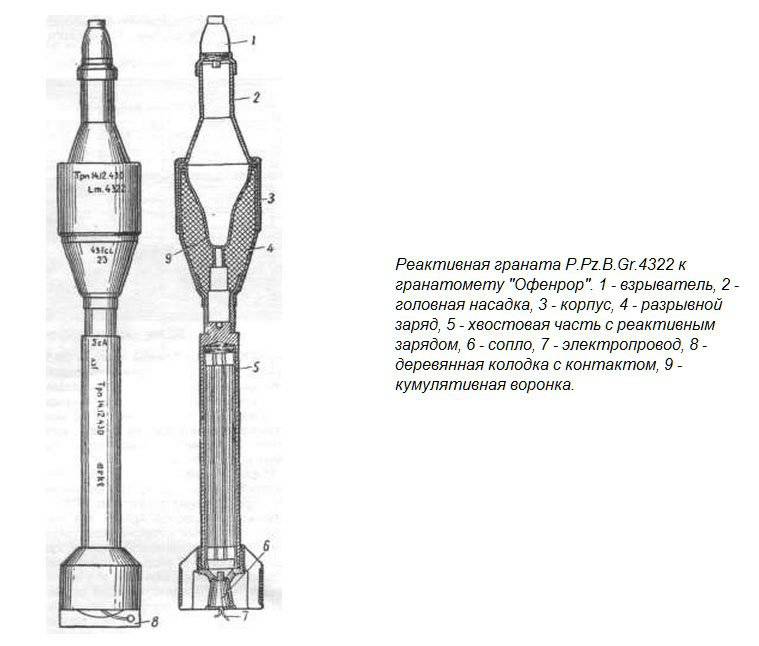
The Wehrmacht was armed with an effective weapon in the 1943 year - the “Panzerfaust” dynamo-jet device, (“Panzerfaust”) which is referred to in the literature as “faustpatrone” (“faustpatron”). The name “Panzerfaust” (“armored fist”) is often associated with a medieval legend about a knight who had a “steel arm”. The first experiments with a dynamo-reactive weapon in which a cumulative grenade was used were carried out in the summer and autumn of 1942. In December, adopted the first model.
Several models of “Panzerfaust” were adopted, under the designations F-1 and F-2 (“43 system”), F-3 (“44 system”), F-4, which had a fundamentally identical design. It was a disposable grenade launcher, built on the scheme of a recoilless gun, which was developed by G. Langweiler. The basis was an open steel pipe-barrel with a trigger mechanism and a propelling charge. Front grenade was inserted into the pipe. The propellant charge (smoked gun powder) was placed in a cardboard case and was separated by plastic wad from a grenade. A tube of the percussion mechanism was welded to the front of the barrel, which included a hammer with a combat spring, a retractable stem with a screw, a release button, a return spring, and a sleeve with a primer-igniter. To cock the impact mechanism, the stem was fed forward, leading to the pilot hole of the cap. In order to remove the mechanism from protection, the stem was delayed and turned. Pressing the button made the descent. The strike mechanism was safely removed from the platoon. A flap with a hole served as a sight, a front sight - the top of the rim of a grenade (there was no sight on the prototype of the weapon). In the stowed position, the bar was attached to the grenade's ear with a check. At the same time, it was impossible to cock the impact mechanism. Usually for a shot the weapon was taken under the arm. At very short ranges they shot from the shoulder.
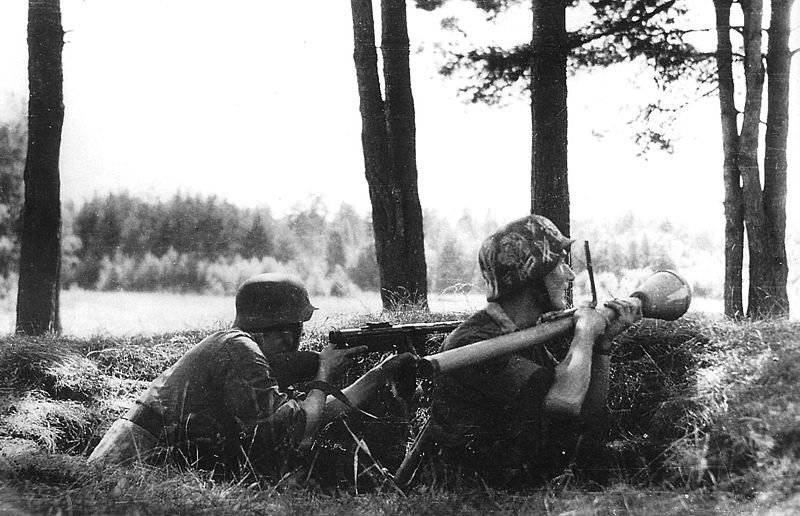
The grenade consisted of a hull and a tail. The cumulative charge (a mixture of TNT and RDX), which was covered with a ballistic tip, was placed in the case. The tail section in the curb form included a metal cup with a bottom detonator and an inertial fuse, as well as a wooden rod having an 4-blade stabilizer. The stabilizer blades in the collapsed position were opened after leaving the barrel grenades. The F-2 model was demonstrated in March of the 1943 of the year at the Kummersdorf testing ground, however, a mass order for its production was issued only in September, at which time the F-1 was already being delivered. Grenade caliber F-1 - 100 millimeters charge mass - 730 grams, armor penetration along the normal - 140 millimeters. F-2’s equivalent figures were 150 millimeters, 1660 grams and 200 millimeters, respectively. The shape of the F-1 tip was designed to improve the cumulative jet. The initial speed of grenades was 30 and 40 meters per second. Sighting range reached 30 meters. From here came the names of the models “Panzerfaust-30 Klein” and “Panzerfaust-30 gross”.
The first batch of "Panzerfaust" in the amount of 8 thousand pcs. was released in August 1943 year, in October, began their mass production. However, it was not until April of 1944 of the year that the planned production level was reached - 100 thousand F-1 and 200 thousand F-2. Accordingly, in the spring of 1944 of the year, extensive use of hand-held anti-tank grenade launchers began, which became widespread at the end of 44.
The third model (“Panzerfaust-60”, F-3) had an 150-millimeter grenade and an increased propelling charge, a large target range and an elongated barrel-tube. The sighting bar had three holes - 30 m, 50 m and 75 m.
In September, the 44 was developed by the Panzerfaust-100 (F-4) model. At the beginning of the 1945 goal, this hand-held anti-tank grenade launcher was put into production. It used a double-throw propelling charge (between the charges there was an air gap), which due to the back pressure of the second charge ensured a firing range of up to 100 meters.
Weapons painted in dirty yellow or dark green. Behind the pipe, when fired, a bundle of flame escaped to 4 meters, which was warned by the inscription “Attention! A ray of fire! ”(“ Achtung! Feuerstral! ”).
The Panzerfausts were simple both in making and mastering. Traditional for the German industry standardization made it possible in a short time to connect to the production of several companies. If in July 44 of the thousand “panzerfausts” was released, then in October their figure increased to 323 thousand, in November - 400 thousand (according to other data, 997 thousand), in December - 1100 thousand . (or 1253 thousand), in January 1300-th - 45 thousand. For the first quarter of the year 1200 released "Thousands of Panzerfausts". These grenade launchers were also easy to use - all that was needed was a short training in aiming, positioning and shooting. 1945 January 2800 was ordered by Hitler to create a “tank-fighter division” formed from mouths of scooters with “panzerfaustami”. "Kancerfausta" issued not only to the troops. A large number of these hand-held anti-tank grenade launchers were handed over to the boys from the "Hitler Youth" and the fighters of the Volkssturm. At the end of 26, more than 1945 thousand "Panzerfausts" were handed over to the "Folkssturm".
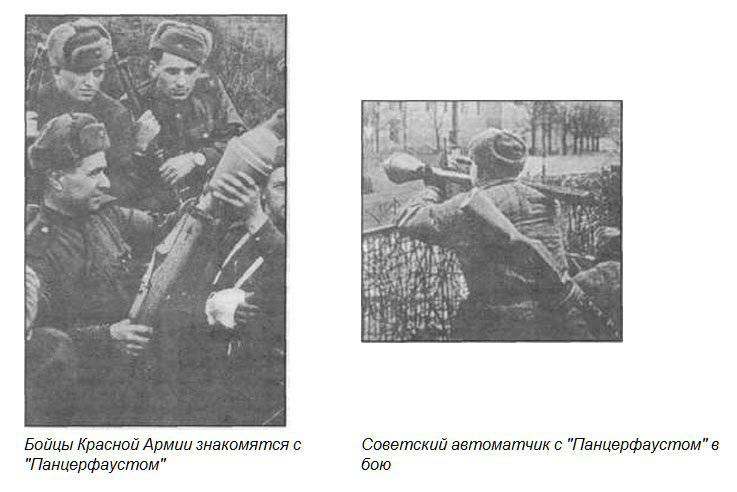
“Faustniki” were a dangerous adversary, especially in the case of fighting in urban environments, where tanks were widely used by Soviet troops. Although the gas jet of high temperature and long length formed behind the pipe made it difficult to shoot from cramped rooms, the infantry quickly adapted to firing from buildings. For example, during the East Pomeranian operation in the second mechanized corps of the second Guards Tank Army, about 60% of the lost tanks were shot down by “panzerfaustami”. It was necessary to supply tank divisions with infantry landings (the usual reception of the Soviet army, practiced from the initial period of the war), and to allocate specials. groups of machine gunners and shooters to combat the "faustnik". In the spring of 1945, in battles near Berlin, tank losses from these weapons ranged from 11,3% to 30% (in various armies). During street fighting in Berlin, this figure was even higher. About 10% T-34, which were lost during the Berlin operation, were destroyed by "faunters" (although a significant percentage of casualties in armored vehicles in street fights were revealed even before the adoption of the Panzerfautsst). During the movement of tanks with an open hatch there were cases when grenades fired from an ambush by the Panzerfaust fell into the open hatch of the T-34. During the “Panzerfaust” shot, they unmasked the position with raised dust and a white spherical cloud, but their one-time nature allowed the soldier to quickly leave the place from which the wiper was made. Trophy “Panzerfausts” in the Red Army were used not only against armored vehicles and tanks, but also against fortified firing points. Especially willingly, the Panzerfausts used the fighters of the assault groups during the city battles and the sappers to fight the long-term fortifications. Colonel-General Chuikov, Commander of the 8 Guards. the army, noting the soldiers' interest in "faustprony" ("panzerfaustam"), offered to introduce them to the troops, giving a half-joking name "Ivan-patron". Chuykov’s remark about the battles in the city is typical when “tanks are a good target for armored combatants who have incendiary bottles and especially rocket launchers like Faustpatron”, and should work only as part of a mixed assault group grenade launchers on the streets of cities Russian troops continued after half a century).
Naturally, German specialists sought to expand the capabilities of an easy-to-use and manufacture of infantry combat weapons. As an anti-personnel vehicle, a variant of “Sprengfaust” (“Sprengfaust”) was developed which has a cumulative fragmentation grenade. This grenade was launched on a steep trajectory (a kind of recoilless mortar). The explosion followed when hitting the ground. Grenade gave a lot of small fragments. Information about the mass production of "Sprengfaust" is missing.
At the beginning of 1945, the Panzerfaust-150 appeared, having an increased firing range. For reliable destruction of the crew of the armored vehicle and combat with manpower, a special shirt was worn on the warhead of the grenade, which formed fragments during the explosion of the warhead. This type of weapon would be very effective, but the war was already coming to an end. Data on the size of the release of cumulative frag grenades are also missing.
In 1945, the “Panzerfaust-250” model was developed, but did not put into production a reusable, that is, rechargeable, model. The firing range reached 200 meters.
According to British and some Soviet technical and military specialists, Panzerfaust was "the best armored infantry weapon in the fight against tanks of the Second World War."
At the beginning of 1942, in the United States, at the Aberdeen Proving Ground, a jet weapon developed on the initiative of Colonel Skinner and having a cumulative warhead was tested.
According to some data, the development of an anti-tank launcher (start-up from the shoulder) was conducted in the United States since the 1933 year, according to others - from the 1941 year, but it accelerated its information about the Schulder 75 rocket system (Germany), which the Americans used in the design. After a successful demonstration in the US Army decided to order 5 thousand pieces of anti-tank grenade launchers. The order was issued to 19 in May by 1942 of General Electric. This anti-tank rocket launcher was adopted by the American army under the designation МХNUMX ("bazooka", "Bazooka"). His nickname was a hand-held anti-tank grenade launcher received by the troops - it is believed that the grenade launcher was named after a wind musical instrument used by comedian Bob Bern.
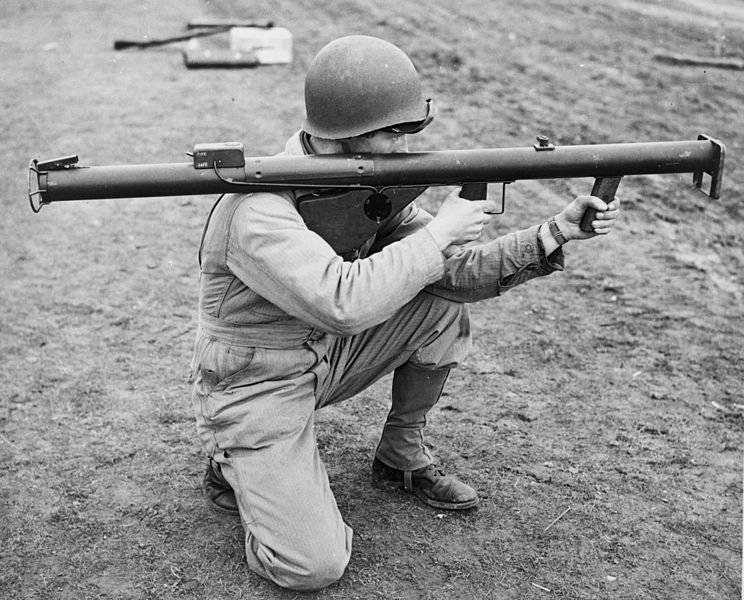
The hand-held anti-tank grenade launcher consisted of a smooth-walled open tube, an electric igniter, sighting devices, a safety box with a contact rod, a shoulder rest and a pistol grip. The breech cut of the pipe had a wire ring protecting the pipe from contamination and facilitating the insertion of grenades, and the barrel cut was a round shield protecting against powder gases. To hold the grenade there was a spring latch located at the breech cut from above. The electric igniter consisted of two dry batteries, a warning light, an electrical wiring, and a connector (trigger located in front of the pistol grip). The wiring was carried out according to the scheme with one wire, the second “wire” was the pipe itself. The red light bulb (located on the left side of the shoulder rest) when the trigger was pulled indicated that the wiring and the batteries were in good condition. The safety box was located in front of the latch on top. Before loading to turn on the fuse, its lever was lowered to the “SAFE” position, before being shot, to turn it off, to the “FIRE” position. Aim devices were on the left side and included a front viewfinder (frame with four front sights at a fixed range) and a rear viewfinder (slot). For carrying there was a shoulder strap. The M6AZ gauge rocket grenade consisted of a streamlined body with a shaped charge, a bottom inertial fuse (equipped with a safety check) and a ballistic tip, a powder-driven jet engine driven by an electric fuse and a stabilizer with 6 loops. The contact of the electric ignition device of a hand-held anti-tank grenade launcher with an electric igniter of a grenade engine was provided by a contact ring located on the ballistic tip and a contact behind the grenade body. The length of the grenade was 536 millimeters, the initial speed was 81 meters per second, and the maximum speed was 90 meters per second. Target maximum range of fire on tanks - 200 meters, for defensive installations - 365 meters (400 yards). Shooting led from the shoulder. For carrying garnet served special cylindrical closures.
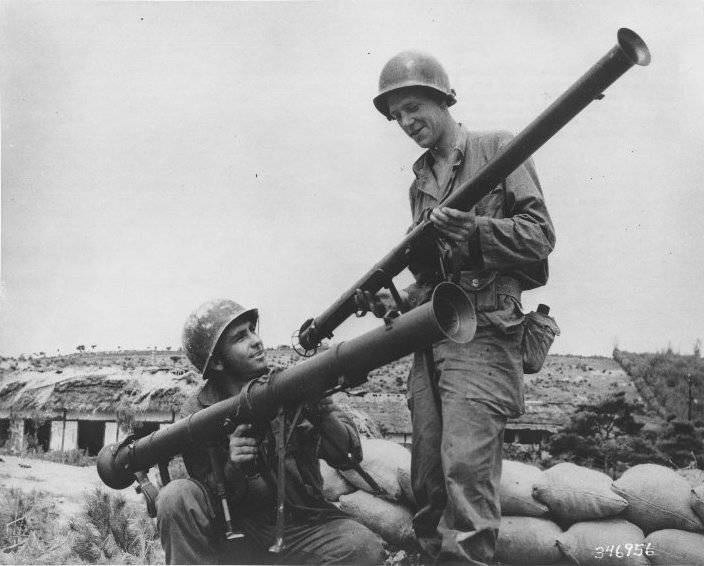
"Bazooka" was very easy to use, but the armor penetration of the grenade was insufficient. Despite this, the design of the М1 "Bazooka" for a long time determined the further path of development of hand-held anti-tank grenade launchers. In English-speaking countries, the name "bazooka" - as in German-speaking "Panzerfaust" - has become a household name.
For the first time, the M1 Bazuka was used in 1942 in North Africa. There is evidence that in 1943, Italy quite often found grenade throwers with a “bazooka” crushed by German tanks - probably the result of the unreliability of an electric igniter or poor preparation of calculations that hit the tanks head-on (in this case, the zabronevy effect of a cumulative jet was often insufficient) . The grenade launcher trigger and the rocket engine of the grenade proved to be sensitive to moisture — for example, in August 1944 of the year on Tarawa, the marines were exposed to Japanese tanks defenseless, since the rain had disabled all the grenade launchers. Despite this, the Bazooka hand-held anti-tank grenade launcher was the primary means of an infantry platoon of the US Army to fight enemy firing points and tanks. Production of Bazook increased at a rapid pace - if at the beginning of 1944, they were released around 6000, then in the middle of the year, this figure reached 17000. It is interesting to note that during the same period, the production of anti-tank guns in the United States decreased by a factor of 1,5 - they didn’t seem to be as effective as Bazuki’s infantry combat formations. Each company of an infantry battalion had 5 anti-tank grenade launchers, another 6 was in the company of heavy weapons. In total, 460 thousand of these anti-tank grenade launchers were launched. At the end of 1942, some of their number was transferred to the USSR for study - at least, soldiers in the USSR were trained in their treatment. The Bazuki also passed on to other allies — for example, Chinese units used them against Japanese tanks in 1944 in Burma.
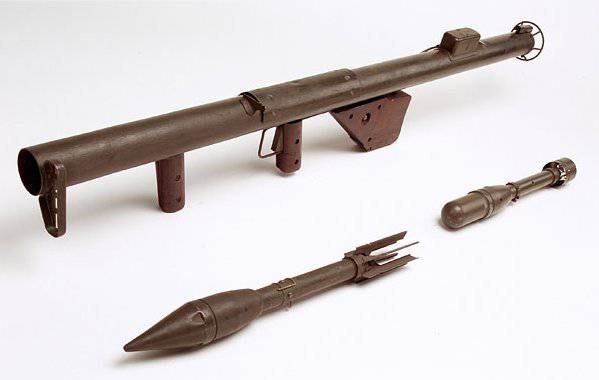
At the end of the 40-s, the M1 was replaced with an 88,9-mm hand-held anti-tank grenade launcher M20 "Bazooka". The maximum firing range was 150-200 meters, armor penetration - 280 millimeters. The grenade launcher, created at the end of the Second World War, entered service during the fighting in the territory of Korea. During the war, a single-barreled 115-millimeter wearable rocket launcher M12 "Bazuka" was also used. The launch tube of this grenade launcher was suspended between tripod legs. However, the accuracy of the M12 was extremely low. After the war, the French 73-mm M.50 anti-tank grenade launcher became a curious combination of elements of the German Pantsershrek and American Bazuka.
In the US, 1943, the M57 18 millimeter recoilless gun, was successfully tested in the year. The gun hit the front only in March, 1945. With a weapon's length in 1570 mm, its mass was 20 kg. The mass of the projectile was equal to 1,2 kg. The M18 was close to hand-held anti-tank grenade launchers - shooting was done from a light tripod or from the shoulder. Maximum range - 400 m. Used optical sight. A more successful model was the 75-millimeter cannon 52 kilogram mass. However, its development began in October 1944 of the year, and release only in the 1945 year and it did not have time to prove itself in the Second World War. But the M18 and the M20 performed well during the Korean War. Delivery of these grenade launchers was carried out in many countries. For example, in China, their production was arranged under the designations “Type 36” and “Type 52” (the United States handed over to the Kuomintang government documentation and helped in setting up production).
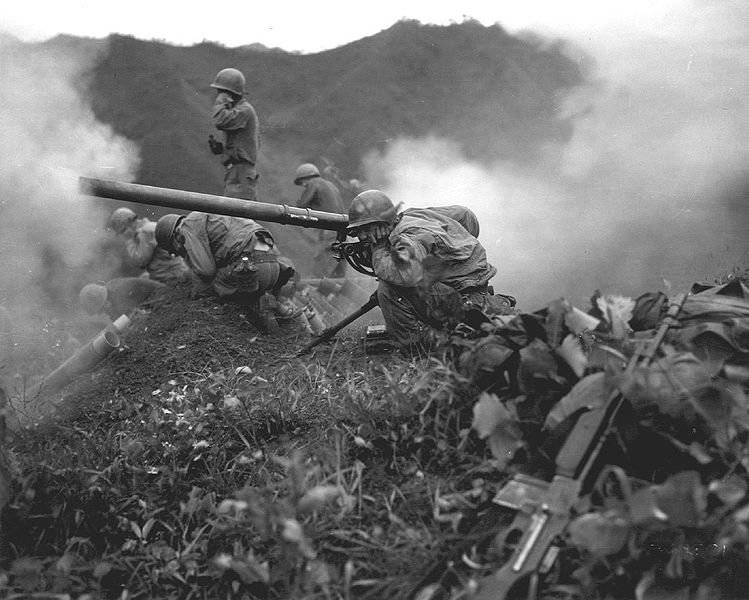 [Center]
[Center]In the UK, an anti-tank "semi-automatic" grenade launcher was created on the basis of a wearable mortar "bomber Blacker" (developed by Col. Blacker) in the UK in 1941. In 1942, it was put into service, giving the designation "PIAT" Mk.l ("Projektor Infantry Anti-Tank, Mark I"). The design consisted of a pipe, to which a tray was welded to the front, a massive bolt-hammer, a recoil spring, a bipod, a trigger mechanism, a shoulder rest having a shock absorber cushion and sighting devices. When loading pomegranate (mine) was placed on the tray, closing the pipe.
Semiautomatic worked at the expense of recoil bolt-drummer. Drummer after a shot rolled away, getting back on the sear descent. When the trigger lever was pressed, the drummer released the trigger and rushed forward under the action of the return-spring spring by breaking the propellant cap. Moreover, the shot was carried out "with a roll-out", that is, before the shutter arrived in the front extreme position. At this time, the sear escaped from the trigger lever and, when rolled back, could seize the bolt. Before the first shot, the bolt was cocked manually, which required considerable effort, since the reciprocating-combat spring was quite rigid. On the trigger mechanism on the right there was a safety lever. Locking was done by turning the flag forward. The stop of the movement of the shutter and the guide rod is the stem of the shoulder stop, which closes the pipe from behind. On the left side were placed aiming devices which included a folding diopter sight and a front sight. The sight had two diopters - at a distance of 64, 91 meter (70, 100 yards). Near the diopter sight, an arc sight was attached with a level designed for shooting at significant ranges. The bipod was attached to the pipe behind the tray with the help of a clip with a lamb. In front of the shoulder rest there was a casing designed to hold with the left hand.
The grenade consisted of a streamlined body and a tail tube equipped with an annular stabilizer. The corps contained a cumulative warhead, a shock fuse (at the end of the head pin), and a bottom blasting cap. The ray of fire of the fuse through the "fire-transfer" tube was transmitted to the detonator cap. The propellant charge and the cap were placed in the tail tube. The weight of the combat charge was 340 grams, the initial speed of the 77 grenade meters per second, the maximum range of fire on the tanks - 91 meter, on the structures - 300 meters, standard ammunition consisted of 18 grenades. For carrying "PIAT" served as a shoulder strap.
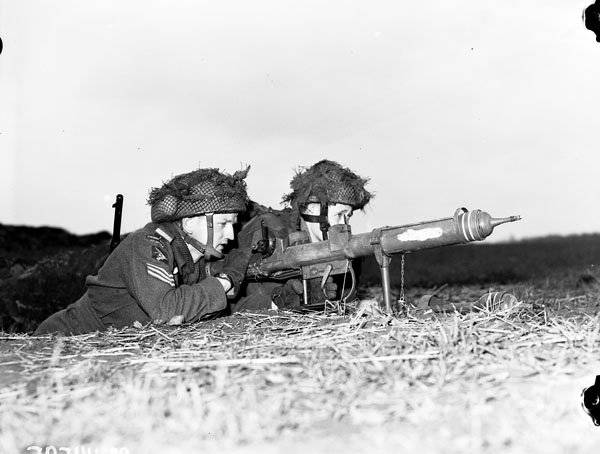
The attribution of “PIAT” to “recoilless” or reactive systems seems erroneous: the combustion of the propellant charge before the grenade was completely off the tray, the return was absorbed not by the reaction of the gas jet but by a massive shutter, a shot from the rollout, springs and a shoulder pad. The PIAT grenade launcher was more likely a transitional model from rifle systems to jet systems. The absence of a gas jet made it possible to fire from a closed room. The disadvantages of "PIAT" could be attributed to the large mass and difficulty of manual cocking. The method of loading did not give the opportunity to shoot with significant angles of decline, because the grenade was dumped from the tray.
Total ICI has released more than 100 thousand such anti-tank rocket launchers. "PIAT" was considered as the main anti-tank infantry in companies and battalions on the ground, where the use of anti-tank guns is difficult. The PIAT calculations were incorporated into the infantry battalion headquarters company and the support company.
The PIAT grenade launchers performed well under Monte Cassino in May 1944, in the hands of the shooters of the Second Lancashire Regiment - after this battle, the shooter Jefferson was awarded the Victoria Cross for the destruction of two tanks. Resistance units also received PIAT - in particular, they were used by the Craiova Army in 1944 during the Warsaw Uprising. "PIAT" also delivered to the Soviet Union, but data on the use of these grenade launchers in the Red Army is not. In the summer of 1947, PIAT’s own production was established for Hagana Israel in Palestine. In service with the British Army, the PIAT was replaced by a British Bazooka anti-tank grenade launcher in the 1951 year.
Manual anti-tank guns, replacing the anti-tank guns as the main infantry anti-tank melee weapons, were able to “unload” and anti-tank guns. The introduction of grenade launchers for the Airborne Forces also played an important role because they were very vulnerable to mechanized units — in the United States, an M9 grenade launcher, a Bazooka variant with a collapsible barrel, was created for the Airborne Forces units.
During the war, “positional” anti-tank weapons appeared, which include heavy mounted grenade launchers. On the Soviet-German front, 1944-mm Puphen grenade launchers appeared in 88, which outwardly resembled a simplified artillery gun or even a fake (hence the nickname “Puppchen” - “doll”). “Puppchen” worked according to the active-reactive principle: the barrel locked the gate-door, and the powder gases of the grenades were used to push it out of the smooth barrel. Grenades had a shorter length and other igniting device of the engine.
The barrel was a 1600 mm pipe, enclosed in a casing having a muzzle, which served to disperse the gases and also reduce heat load. The counterweight placed on the breech facilitated the aiming. The shutter was locked using a crank and a handle. The shutter was assembled safety, shock and throwing mechanisms. For descent served a special lever. Sights included an open sight having notches from 180 to 700 meters and a front sight. The barrel with the bolt and breech fit on the pins in the upper machine gun carriage, which was welded from stamped parts. On the upper machine there was a 3 mm shield with an aiming window and edges bent inward. The lower machine consisted of a single-beam bed with a rule, a hinged paw and a permanent opener. Stamped wheels with rubber tires or runners were mounted on the bed. During the campaign, the trunk was attached as a counterweight to the frame. Lift and swivel mechanisms were absent. The horizontal aiming angles on the runners are 360 °, on the wheels ± 30 °, and vertically from 20 ° to + 25 °. The maximum flight speed of a grenade is 200 meters per second. Maximum armor penetration of 150 mm. On the shield there was a plate for firing at tanks. The Puphen easel grenade launcher was disassembled into six parts: the barrel (weight 19 kg), the lower machine (weight 43 kg), the upper machine (weight 12 kg), the counterweight (weight 23 kg), wheels (each weight 22 kg). "Pupchen" was notable for its simplicity of design. The quantitative ratio of easel and hand grenade launchers can be judged by the following figures: in the Wehrmacht on March 1, 45, there were 1649 “Pupchen” and 139700 “Pantsershrek”. The 80mm recoilless smoothbore gun PAW 600 (PWK 8H63), developed in the development of Pupchen, was an artillery weapon. Pupchen grenade was used during development aviation Panzerblitz unguided anti-tank missile.
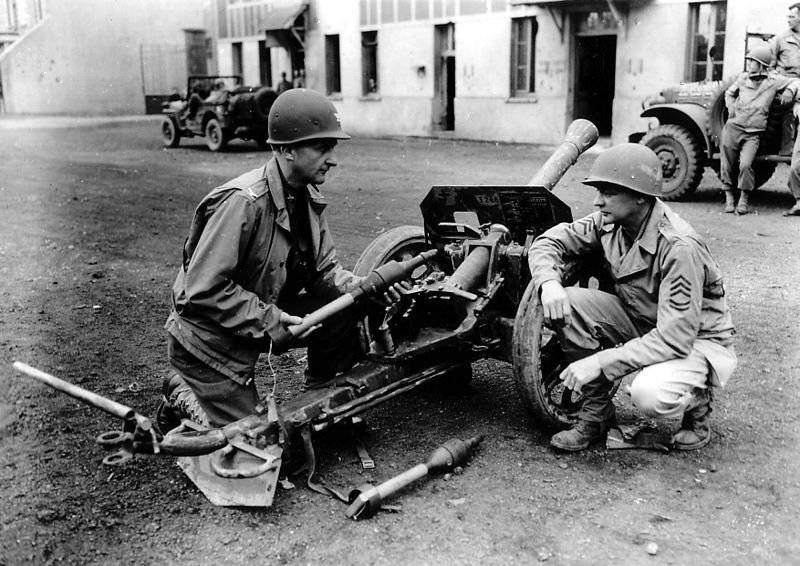
Rheinmetall-Borzig developed a 105-millimeter anti-tank anti-tank unit known under the designation “Hummer” or “Panzertod”: a two-meter assembly tube was mounted on a tripod, the firing range of an 88-mm-sized under-grenade reached 500 meters. The installation was serviced by two people. However, further the prototype did not progress. To defeat heavy tanks, an 105-millimeter portable installation with a 250-mm Hecht-caliber rocket grenade was developed, the armor penetration reached 250 millimeters, but the firing range was only 50 meters. She was also not used in battles.
Easel reusable grenade launchers with over-caliber and caliber grenades were also created in the USSR: SKB-36 (SKB No. 2) of the Oil Industry Commissariat (head Ostrovsky, chief designer Grigoryan) - SPG-82, SKB of the Moscow Mechanical Institute (head Nadiradze) - SPG- 122. Group Ostrovsky formed at the Moscow Petroleum Institute. Gubkina in March 1942. In May of the same year, she presented a prototype LNG-82. The group was transformed into SKB No. 36, Shumilov was attracted to the works. For the grenade launcher chose a jet scheme and the already developed "rocket" and "mortar" caliber 82 millimeter. Initially, the NKBP NII-6 developed a turbojet grenade — the accuracy of the firing should have been ensured by rotation due to the tangential action of the powder gases. However, the rotation of the grenade significantly weakened the effectiveness of the cumulative jet, so in 1944, work was focused on a non-rotating grenade with a hard plumage. The Nadiradze model (LNG-122) was a continuation of the theme started at TsAGI - the launcher for firing from the machine or arm (conditional name "System"). This project was originally used turbojet. At the beginning of 1944, 408 units were manufactured. 82-millimeter "jet guns" with armor penetration to 80 millimeters. However, the tests were unsuccessful. It took a lot of time to work out the propellant charge, which was supposed to work normally at temperatures from -40 to + 40 ° C and also completely burn out in a two-meter launch tube (until the moment the grenades came out of it). Development work on the LNG-122 and LNG-82 was completed only in the 1948 year. In 1950, SG-82 was put into service with a shot (cumulative grenade) PG-82. Aim range - 300 meters, armor penetration - up to 175 millimeters. Subsequently, these mounted reusable grenade launchers became the basis for the recoilless guns B-10 and B-11.
In Hungarian units in 1945, in the area of Budapest, a heavy-duty grenade launcher was captured, which was intended to destroy specially protected targets. The grenade launcher had a single gang wheeled carriage with folding up wheels and a coulter. A light frame was installed on the rotator, having two 60-millimeter launch tubes and a side shield that protected the gunner from gases. Both grenades were launched at the same time. The maximum sighting range is 240 meters. The above-caliber rocket grenade - the so-called “Salashi Needle” (probably named after the head of the Hungarian government) - consisted of a streamlined body, a powder jet engine, and a turbine that provides rotation in flight and stabilization. In the case there were two consecutive shaped charges. The first (having a smaller diameter) worked from the detonator and the shock fuse, punching the screen protecting the target, the second detonated with a slight delay after the first explosion. By the end of the war, the appearance of weapons designed to hit screened targets was characteristic — by this time, anti-cumulative screens were used (additional armor plates on the turret and sides, sandbags, wooden bars or armored spring nets from the beds).
Thus, by the end of the world war, several types of anti-tank grenade launchers of recoilless and reactive schemes had been worked out - reusable and disposable hand-held grenade launchers, and reusable heavy-duty grenade launchers for small and medium ranges. E. Schneider, a former Wehrmacht Lieutenant General, wrote: "Only shaped charges, which are connected to a recoilless system ... or having a rocket engine ... were a very successful means of anti-tank defense at short distances." However, according to Schneider, they didn’t solve the problems: “The infantry needs one person to serve anti-tank weapons and at the same time it would hit the tank from a distance of at least 150 meters and, if possible, 400 meters.” E. Middeldorf adhered to a similar point of view: “The appearance of the Panzerfaust grenade launcher and the Ofenror anti-tank rifle can only be viewed as a temporary measure to resolve the problems of the anti-infantry defense.” Guderian, acknowledged significant changes in the war years in the anti-tank defense system, but he believed that "most issues remained unresolved and, above all, the issue of anti-tank infantry defense, which is always at the forefront." Immediately after the war, many experts saw “problem solving” in light recoilless rifles (such as the American 57-millimeter М18 and 75-millimeter М20 on tripods or the German LG-40 on a tripod or wheeled carriage) as well as in controlled anti-tank shells on high-performance vehicles . However, subsequent local wars showed the important importance of hand-held anti-tank grenade launchers, while the recoilless guns were relegated to the background. The idea of a light and easy-to-use disposable hand-held anti-tank grenade launcher at Panzerfaust proved fruitful in terms of “super-standard” individual anti-tank melee weapons. Since 60-s, after new materials allowed to reduce the weight of hand-held anti-tank grenade launchers, they became very popular (Soviet RPG-18 "Fly", American М72).
The source of information:
The magazine "Equipment and weapons" Semen Fedoseev "Infantry against tanks"
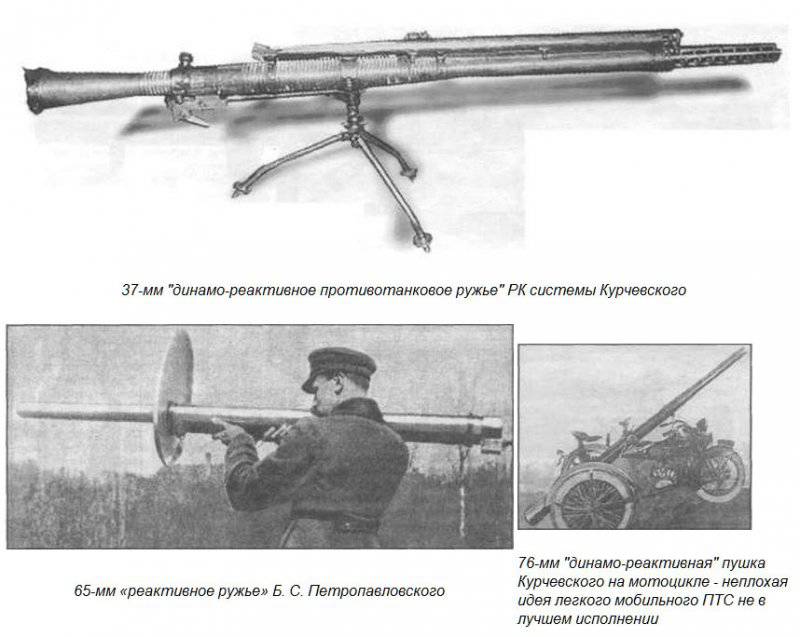
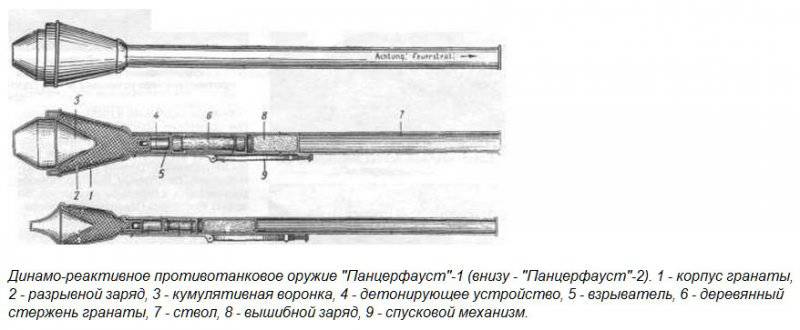
Information